![]()
![]()
![]()
Use LEFT and RIGHT arrow keys to navigate between flashcards;
Use UP and DOWN arrow keys to flip the card;
H to show hint;
A reads text to speech;
51 Cards in this Set
- Front
- Back
|
What is Diabetic Retinopathy (DR)? |
Characteristic group of retinal lesions found in individuals with Diabetes Mellitus (DM) |
|
|
What percentage of cases of blindness worldwide does DR account for? |
4.8% |
|
|
What if DR leading cause of in the UK? |
Leading cause of PREVENTABLE sight loss in UK working age population |
|
|
What increases prevalence of DR? |
• Px age (variable evidence) • Duration of diabetes • Ethnicity (Asian/African-Carribbean, >T2) • Anaemia |
|
|
What increases prevalence and progression of DR? |
• Poor glucose control • Poorly controlled BP & Hyper-lipidaemia • Smoking • Obesity (DR earlier onset) • Pregnancy • Nephropathy |
|
|
What supplies the inner 6 layers of the retina (ILM- OPL)? |
Central retinal artery |
|
|
What supplies the outer 4 layers of the retina? |
Choroidal vessels |
|
|
What are the 3 structural changes to vessels caused by hyperglycemia? |
• Basement membrane thickening • Selective pericyte loss • Endothelial cell changes |
|
|
What are the physical consequences from damage to the vessels? |
• Micro-vascular leakage • Micro-vascular occlusion |
|
|
What is Micro-vascular leakage? |
• Disruption to inner blood retinal barrier • Increased vascular permeability leads to loss of vascular contents = leakage |
|
|
What does Micro-vascular leakage result in? |
• Leakage of plasma • Release of lipids, lipo-proteins & blood • Retinal oedema (diffuse/localised) |
|
|
What is Micro-vascular occlusion? |
• Vessel closure (》Ischaemia) • Thickened basement membrane & Endothelial cell loss • Changes in red blood cells-affects O2 transport • Increased ‘stickiness ’& aggregation of platelets |
|
|
What does Micro-vascular occlusion lead to? |
• Formation of abnormal arterio-veneous shunts within the retina • Formation of ‘new’ vessels |
|

What is a microaneurysm? |
• First clinically detectable retinopathy feature • Focal dilatation of capillary wall (due to pericyte loss) • Small, round, red ‘dots’ |
|
|
What layer of the retina is a microaneurysm usually seen? |
• Inner nuclear layer of retina • Commonly temporal to macula |
|
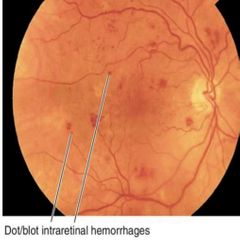
What are haemorrhages? |
'dots and blots' • Ruptured capillary or micro-aneurysm • Round or oval • ‘dot’- Same size as microaneurysms • ‘blot’- larger |
|
|
What layer of tbe retina are dots and blota found? |
Middle retinal layer |
|
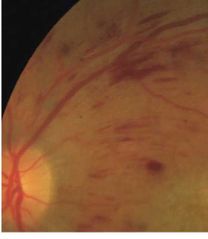
What is this? |
Flame shaped/Splinter haemorrhage
• Follow course of retinal nerve fibre layer • Feathered appearance |
|
|
Where in the retinal layer would a flame haemorrhage be seen? |
More superficial |
|
|
What are hard exudates? |
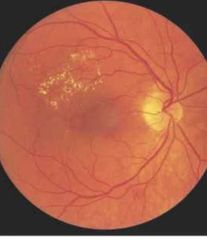
• Intra-retinal lipid exudates • Lipid leakage 》 capillaries & micro-aneurysms |
|
|
What layers of the retina is hard exudates found? |
Between inner plexiform & inner nuclear layer |
|
|
DR features location |
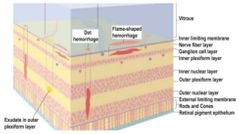
|
|
|
What are cotton wool spots? |

• “Soft exudates” • White ‘fluffy’ lesions • Interrupted axoplasmic flow • Build-up of transported axonal matter |
|
|
What layer of the retina are cotton wool spots found? |
Pre-capillary arteriole occlusion in nerve fibre layer (> superficial) |
|
|
What can cotton wool spots be a sign of? |
Capillary non-perfusion- Ischaemia |
|
|
What is oedema? |
• Increased retinal capillary permeability • Appears as retinal thickening |
|
|
What layers of the retina would you find oedema? |
• Starts in outer plexiform & inner nuclear layers • Progresses to nerve fibre layer (full thickness) • Obscures underlying RPE & choroid |
|
|
What should you check for if you see oedema? |
VA and Amsler chart |
|
|
What does IRMA stand for? |
Intra-retinal micro-vascular abnormalities |
|
|
What is IRMA? |
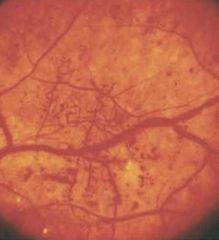
• Retinal ischaemia • Formation of new FLAT capillary networks • Abnormal irregular patches of branching vessels • Do not cross over major retinal vessels |
|
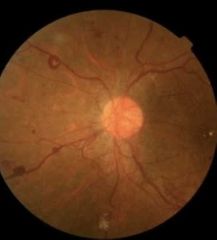
What other vascular changes can occur with VEINS in DR? |
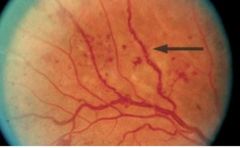
• Dilation • Tortuosity • Beading (focal dilation & narrowing) • Looping (may arise from focal vitreous traction) • Segmentation ‘sausage like’ (appears as exaggerated beading)
• ALL indicate retinal ischaemia |
|
|
What other vascular changes can occur with ARTERIES in DR? |
• Narrowing (AV ratio?) • Possible obliteration (will resemble branchretinal artery occlusion) • Link with HTN |
|
|
What is the chain of events Ischaemia promotes? |
• Production of Vasc. Endothelial Growth Factor • leads to Abnormal New vessels (neo-vascularisation) • Originate from veneous circulation • Between internal limiting membrane & posterior vitreous • Present @ disc (NVD) or elsewhere (NVE)
• Weak, leaky structure (fenestrated endothelial cell junctions)》 highly prone to leakage |
|

What is this? |
New vessels at the disc
• Initial finebvascular strands • May appear linear or compact mass of vessels • Tend to follow temporal arcades • Adhere to posterior vitreous with continued growth |
|
|
What else can new vessel growth lead to? |
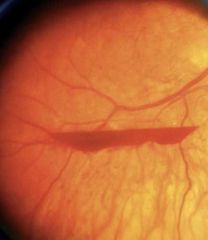
• May spread along posterior vitreous
• NV maturation • Tissue adheres to posterior vitreous • Stimulates vitreous detachment (usually incomplete, if complete-NV’s may regress) • Traction and rupture of NV’s (haemorrhage) |
|
|
What can the leaky vessel heamorrhage lead to? |
• May penetrate vitreous gel • Dark red • Highly symptomatic • Loss of VA • Sudden floaters • Can lead to retinal detachment |
|
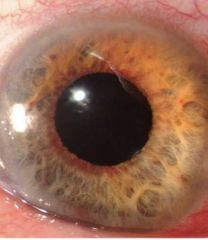
What is this? |
Response to ischaemia • Small fine vessels on anterior iris • Initially at pupil border |
|
|
What can new vessels at the anterior iris lead to? |
• Progress to block.a.c • ‘Neovascular’ glaucoma • Pain, decreass in VA • Increase IOP, Cloudy cornea • Hyphaema |
|
|
What are the 3 types of diabetic maculopathy? |
• Focal • Diffuse • Ischaemic |
|
|
What is focal maculopathy? |
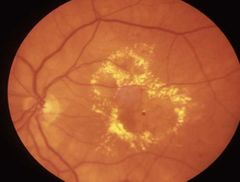
• Micro-aneurysms • Surrounding hard exudate (complete or incomplete ring) • Circumscribed retinal thickening • Focal oedema • Often good VA prognosis |
|
|
What is diffuse maculopathy? |

• Diffuse macula oedema • Obscuration of RPE & choroid • Leakage from vessels & micro-aneurysms • Increased fluid》may show cystoid macula appearance |
|
|
What is Ischaemic maculopathy? |

• Capillary closure • Features may vary (mild-severe) • Large blots haems • Multiple CWS • Veneous changes • IRMA • Variable macula oedema • Poor VA |
|
|
Classification |
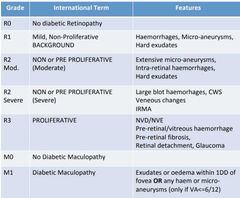
|
|
|
Who gets seen at the NationalDiabetic Eye Screening Programme: NHS England
|
All Diabetics age 12+ annual screening available Results to GP: within 6/52 |
|
|
What are the screening outcomes? |
R0/MO, R1/MO (monoc/binoc): 12/12 recall R2, R3, M1: Early screening review clinic or HES (triaged pending progression/severity) |
|
|
What should you refer the same day? |
–Sudden loss of vision –Vitreous haemorrhage –Retinal detachment –High IOP > 30mmHg (NVI) |
|
|
How do you manage background R1? |
AIM: to prevent progression • Control HbA1c/BP/lipidprofile/Anaemia • Consider Aspirin-reduce platelet stickiness • Education • Ensure annual eyescreening |
|
|
What stages of DR would need closer monitoring? |
• Maculopathy (M1) • Non-Proliferative (R2, Severe) >>Ischaemia • Proliferative (R3) • Advanced diabetic eye disease |
|
|
What is the treatment for M1? |
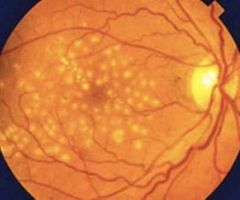
• Spot laser (focal maculopathy) • Grid laser (diffuse changes) • Avoid central fovea (500 microns) • Monthly Anti-VEGF intra-ocular injections (Lucentis, used in ARMD) • May be used in conjunction with laser |
|
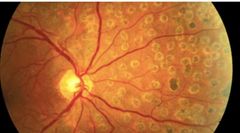
What is the treatment for R2/R3 DR? |
Non-proliferative (R2, severe)- Prevent progression to R3 • LASER Pan-Retinal Photocoagulation (PRP) – Scatter pattern – >> scarring & Visual field loss – tritan colour vision defect? • anti-VEGF injections Proliferative (R3) • Laser (PRP)/Anti-VEGF injections • Combination therapy |
|
|
What is the treatment for advanced diabetic eye disease? |
• Vitrectomy for removal of vitreous • Retinal detachment-surgery • Iris NV’s: PRP, anti-VEGF, glaucoma therapy |

